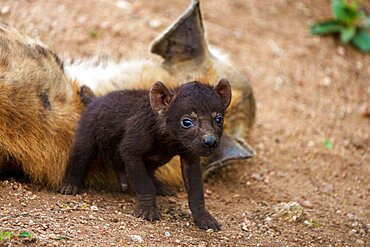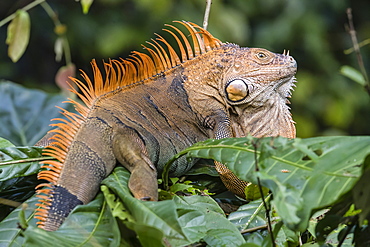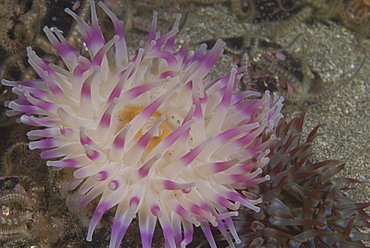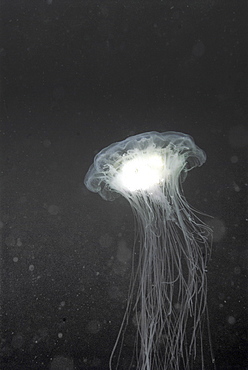Recent searches
Loading...
1112-7377 - A grove of trembling aspens (Populus tremuloides), in fall coloration near Snowbowl, Flagstaff, Arizona, United States of America, North America
1350-6678 - Strawberry Poison Frog (Dendrobates pumilio), adult, Bastimentos National Park, Bocas del Toro, Panama. The strawberry poison frog or strawberry poison-dart frog (Oophaga pumilio or Dendrobates pumilio) is a species of small amphibian poison dart frog found in Central America. It is common throughout its range, which extends from eastern central Nicaragua through Costa Rica and northwestern Panama. The species is often found in humid lowlands and premontane forest, but large populations are also found in disturbed areas such as plantations. The strawberry poison frog is perhaps most famous for its widespread variation in coloration, comprising approximately 15���30 color morphs, most of which are presumed to be true-breeding. O. pumilio, while not the most poisonous of the dendrobatids, is the most toxic member of its genus. The species is most diverse in Panama with varieties in vivid shades of all red, orange, blue, yellow or green, green and yellow, white with red, orange or black and spotted varieties. The most colorful mix is found in Isla Bastimentos Marine National Park though not all in one place. Colors vary by location. A beach on the north side of the island is named after the species. Two of Southern Explorations' Panama tours visit red frog habitat. Both the eight-day Panama Adventure trip and eleven-day Panama Highlights trip spend time in Isla Bastimentos Marine National Park and the former also goes to Red Frog Beach.
The red frog is not as poisonous as some of its cousins and is not a threat to humans. It subsists on a diet of ants that dine on poisonous plants, providing the red frog its protective skin toxin. Males attract females with a loud quick chirp. To hear the distinctive sound before you depart on your Panama tours, go to the University of Michigan Museum's biodiversity website (www.animaldiversity.ummz.umich.edu.) After birth, the tadpoles climb aboard the mother who deposits them in different protected areas where she retu
860-291359 - Spotted hyena or laughing hyena (Crocuta crocuta) cub with its mother. Cubs are born dark brown and when they are 2 - 3 month old, change to the adult coloration. Mpumalanga. South Africa.
1350-8 - Transit of Venus, June 8, 2004, from Luxor, Egypt. A single image taken near mid-transit. Taken with a Sony DSC-V1 digital camera shooting afocally through a 40mm eyepiece and on a 90mm apochromatic refractor, equatorially mounted and driven. Shot thru a Baader solar filter, which gives a white Sun. Yellow coloration added in Photoshop.
1350-7 - Transit of Venus, June 8, 2004, from Luxor, Egypt. A composite image (layered in Photoshop) of individual multiple shots taken from just after 2nd contact to just before 3rd contact. Taken with a Sony DSC-V1 digital camera shooting afocally through a 40mm eyepiece and on a 90mm apochromatic refractor, equatorially mounted and driven. Shot thru a Baader solar filter, which gives a white Sun. Yellow coloration added in Photoshop.
1112-4173 - An adult male green iguana, Iguana iguana, in breeding coloration, Tortuguero National Park, Costa Rica, Central America
1116-39725 - Mouth detail of a colourful and healthy Mushroom coral, Fungia fungites, that is growing on a tropical coral reef in the Philippines. Mushroom coral is unique in the coral world, in that it does not attach itself to the bottom, Philippines
1112-3359 - A wild adult male bee hummingbird (Mellisuga helenae), displaying vivid coloration near Playa Larga, Cuba, West Indies, Caribbean, Central America
869-4897 - sand lizard male portrait nuptial coloration
832-81118 - Champagne Pool, edge, coloration through antimony sulfides, Wai-O-Tapu Thermal Wonderland, Roturoa, North Island, New Zealand
979-7005 - First winter coloration Bonaparte's gull (Larus philadelphia) in flight over the calm waters of Fresh Water Bay on Chichagof Island in Southeastern Alaska, USA. Pacific Ocean.
979-2952 - Juvenile brown pelican (Pelecanus occidentalis) in the lower Gulf of California (Sea of Cortez), Mexico. Note the uniform drab brown coloration of the juvenile plumage.
970-329 - Goldline Blenny (Malacoctenus aurolineatus), great profile of head appearing above algae showing all coloration, Cayman Brac, Cayman Islands, Caribbean
970-365 - Deepwater Dahlia Anemone, (Urticina eques), lovely purple and pink coloration to tentacle detail, St Abbs, Scotland, UK North Sea
979-1957 - First summer coloration Bonaparte's gull (Larus philadelphia) in the calm waters of Takatz Bay on Baranof Island in Southeastern Alaska, USA. Pacific Ocean.
970-244 - Blochs Topknot (Phrynorhombus regius), resting on indistinct rocky surface, showing brilliant coloration, St Abbs, Scotland, UK
979-1367 - Sally lightfoot crab (Grapsus grapsus)close up showing magnificent red coloration in the litoral of the Galapagos Island Archipeligo, Ecuador.
979-2955 - Two juvenile brown pelicans (Pelecanus occidentalis) behind an adult in the lower Gulf of California (Sea of Cortez), Mexico. Note the uniform drab brown coloration of the juvenile plumage.
970-373 - Deepwater Dahlia Anemone, (Urticina eques), lovely purple and pink coloration to tentacle detail, St Abbs, Scotland, UK North Sea
970-230 - Juvenile Porkfish (Anisotremus virginicus), night-time colouration against sandy bottom, Bahamas, Caribbean
970-349 - Lions mane jellyfish (Cyanea capillata), detail showing blue coloration, St Abbs, Scotland, UK North Sea
970-371 - Deepwater dahlia Anemone (Urtina eques), detail showing tentacles and pinkish red coloration, St Abbs, Scotland, UK North Sea
970-331 - Goldline Blenny (Malacoctenus aurolineatus), great profile of head appearing above algae showing all coloration, Cayman Brac, Cayman Islands, Caribbean
970-366 - Deepwater Dahlia Anemone, (Urticina eques), lovely purple and pink coloration to tentacle detail, St Abbs, Scotland, UK North Sea
970-346 - Whiting (Merlangius merlangius), Juvenile on Lions Mane Jellyfish, St Abbs, Scotland, UK
979-7006 - First winter coloration Bonaparte's gull (Larus philadelphia) in flight over the calm waters of Fresh Water Bay on Chichagof Island in Southeastern Alaska, USA. Pacific Ocean.
970-100 - Short Spined Scorpeonfish (Myoxocephalus scorpius), camouflage coloration on seabed, St Abbs, Scotland, UK North Sea
979-2890 - First summer coloration Bonaparte's gull (Larus philadelphia) in the calm waters of Takatz Bay on Baranof Island in Southeastern Alaska, USA. Pacific Ocean.
970-351 - Lions mane jellyfish (Cyanea capillata), detail showing blue coloration, St Abbs, Scotland, UK North Sea
970-372 - Deepwater Dahlia Anemone, (Urticina eques), lovely purple and pink coloration to tentacle detail, St Abbs, Scotland, UK North Sea
970-350 - Lions mane jellyfish (Cyanea capillata), detail showing blue coloration, St Abbs, Scotland, UK North Sea
970-170 - Ballan Wrasse (Labrus bergylta), Nice portrait and side profile of fish with golden/tan coloration and indistinct background, St Abbs, Scotland, UK North Sea
970-342 - Lions mane jellyfish (Cyanea capillata), detail showing blue coloration, St Abbs, Scotland, UK North Sea
979-1749 - Southern Giant Petrel (Macronectes giganteus) on the water around the Antarctic Peninsula. Note the light coloration of the plumage of this animal.
970-249 - Ballan Wrasse (Labrus bergylta), Nice portrait and side profile of fish with golden/tan coloration and indistinct background, St Abbs, Scotland, UK North Sea
970-374 - Dahlia Anemone, (Urticina felina), lovely purple, red and pink coloration to tentacle detail, St Abbs, Scotland, UK North Sea
970-388 - (Facelina bostoniensis), rich red/brown coloration clearly showing red blotches on the head of this nudibranch, St Abbs, Scotalnd, UK North Sea
970-91 - Short Spined Scorpeonfish (Myoxocephalus scorpius), camouflage coloration on seabed, St Abbs, Scotland, UK North Sea
970-343 - Lions mane jellyfish (Cyanea capillata), detail showing blue coloration, St Abbs, Scotland, UK North Sea
979-2891 - First summer coloration Bonaparte's gull (Larus philadelphia) in the calm waters of Takatz Bay on Baranof Island in Southeastern Alaska, USA. Pacific Ocean.
979-2958 - Adult Brandt's cormorant (Phalacrocorax penicillatus) perched on a rock at Los Islotes in the Gulf of California (Sea of Cortez), Mexico. Note the metalic green coloration and blue on the beak. (rr)
You reached the end of search results









































